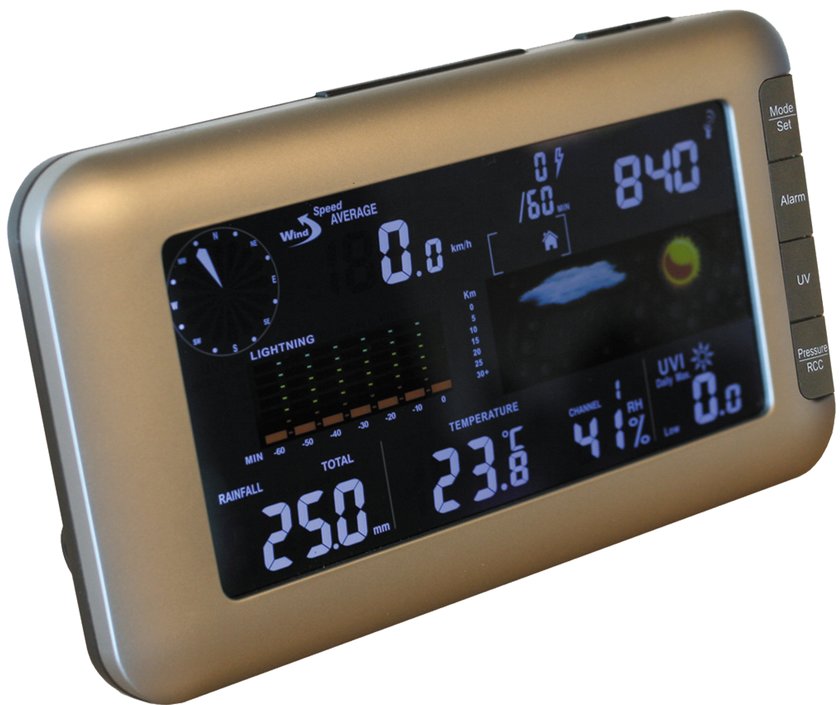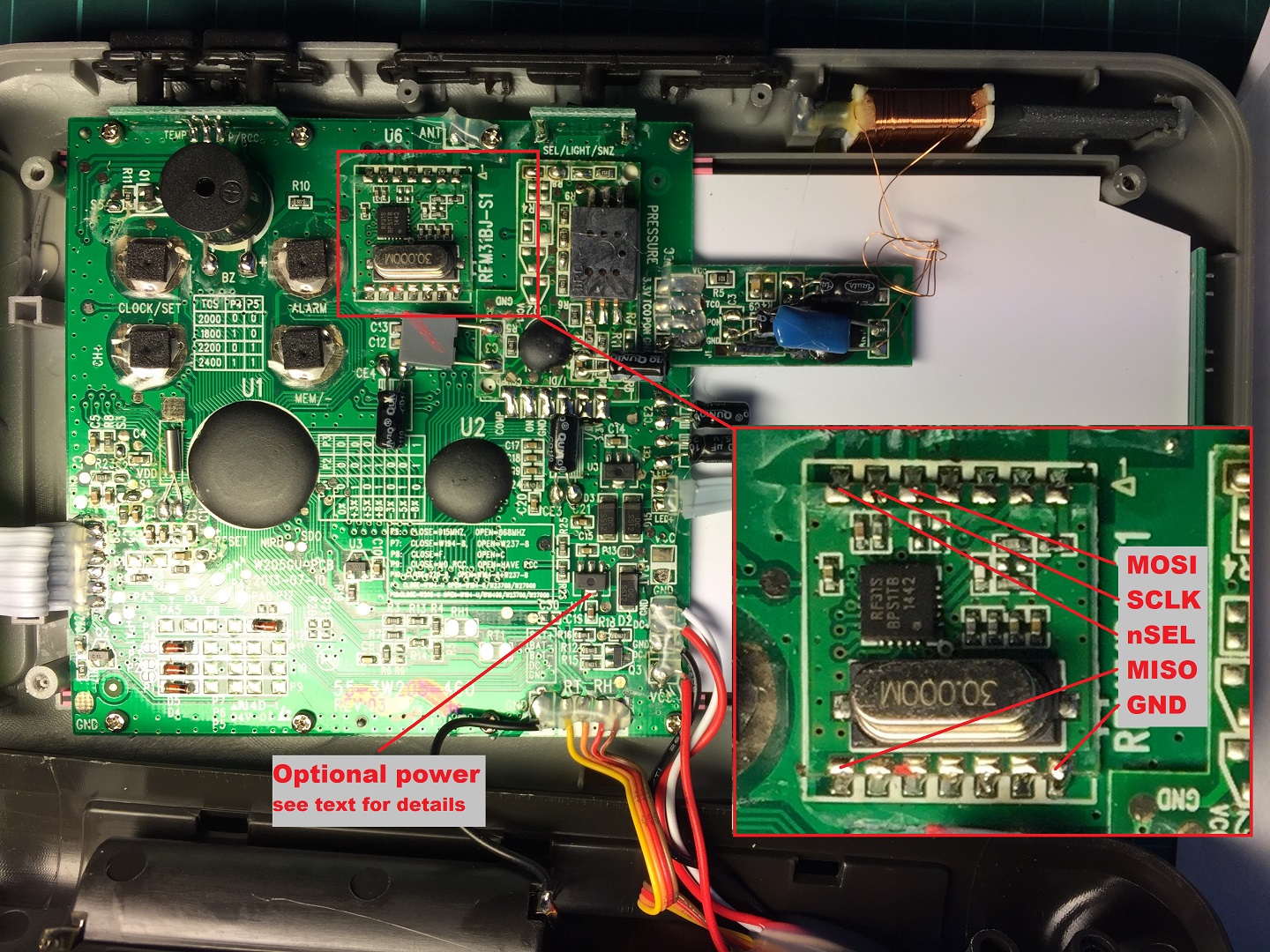Hardware - Ventus W266¶
The weather station Ventus W266 is a indoor + outdoor unit which can detect many weather related values.
Plugin details¶
Type: Hardware
Name: Ventus W266
Status: COLLECTION
GitHub: P046_VentusW266.ino
Maintainer: .
Used libraries: .
Supported hardware¶
Ventus W266¶

Introduction¶
The Plugin for the Ventus W266 is used to connect a Ventus W266 weather station to ESPEasy universe. The Ventus W266 weather station is also sold under the name of RenkForce W205GU.
The weather station is delivered with 2 units and a power supply. The outdoor sensor unit is battery powered by 4 AA type batteries. It is recommended to use lithium type batteries so the power is stable during the freezing winters.
- Specifications (outdoor unit):
Outdoor temperature
Outdoor humidity
Wind direction
Average wind speed
Gust wind speed
Cumulative rainfall
UV index
Cumulative number of lightning strikes
Distance of the nearest lightning strike
- Specifications (indoor unit):
Indoor temperature
Indoor humidity
Barometric pressure
DCF77 clock
Note
Be aware that this plugin is not build by default because it is disabled.
The plugin uses quite a lot of resources like ram and iram. Since the hardware used
is also something special we, the author and datux, decided to keep the plugin out
of the normal builds. Since then, ESPEasy has defined a special hard_Ventus_W266_1M build that
can be installed on any ESP board with at least 1MB Flash that has enough available GPIO pins (so not on an ESP01).
Also, the plugin can be added to a Custom build by following the instructions in PlatformIO.
The plugin can only read the sensors of the outdoor unit.
Danger
CONNECTING THIS PLUGIN WILL VOID THE WARRANTY OF YOUR WEATHER STATION!
If you are not yet prepared to void the warranty have a look at P190_Ventus_W266_RFM69.ino in the playground. The RFM69HCW unit is able to communicate with the outdoor unit using radio, thus you aren’t forced to do any tinkering with the indoor unit.
This device plugin is multi functional and you’ll want to install multiple instances (add the plugin multiple times) of this plugin to get all the different sensor readings. The outdoor unit has up to 9 sensors values and a minimum of 5 sensor types. Most home controllers, like Domoticz, can read multiple values per sensor type. The temperature sensor for instance also reads the humidity and the wind sensor combines two types of windspeed and the direction. You’ll need one instance per sensor type.
The plugin was originally written for use with (and tested on) Domoticz, which did not support custom multi value sensors at the moment (February 2017). This means the lightning detection is send as two instances. In total you could run as many as nine instances of the plugin to get all values.
Wiring¶

ESP Ventus
GPIO (4) <--> MOSI
GPIO (12) <--> SCLK
GPIO (14) <--> nSEL
GPIO (5) <--> MISO
Power
5.0V <--> VCC (read note below)
GND <--> GND
Set up the piggy back ESP unit according to this schematics. We recommend you using a Wemos D1 mini board since these fit nicely.
Note
If your ESP module has it’s own 3v3 regulator you could connect its power input to the optional power pin specified in the image. The supplied power supply however is not powerful enough to supply both the display with the backlight on and an ESP while transmitting. It is safe to exchange the power supply for a USB power supply of 1A (or higher). The display unit is happy and working fine with only the 5 volts. Some adapters supply more then 5 volts, since the original adapter supplied 6 volts this should not be a problem.
Be mindful when you install the ESP unit. Although the space on the right, above the white display, seems to be perfect for placing the ESP, it is very close to the indoor temperature sensor and your readings on the display will be off by approx. +2 degrees because of the heat generated by the ESP. A better position is all the way on the left where a bare ESP-12E fits perfect, just be sure to supply it with 3.3V instead of the 5V from the supply pin in the picture.
When using a bare ESP be sure to apply the necessary ~10K pull-up resistors to CH_PD (CD_EN), GPIO0 and a pull-down to GPIO15 for stable performance and OTA capabilities.
Note
It is not possible to read the indoor sensors using the plugin nor is it in development or planned.
Setup¶
Task settings¶
Note
To get started you need to add the device plugin and set the instance to Main + Temp/Hygro. This instance contains the core functionality of the plugin and is needed to read the data send by the outdoor sensor unit. This instance is the only one that has the ability to set the GPIO pins used.
Device: Name of plugin
Name: Name of the task (example name VentusW266)
Enable: Should the task be enabled or not
Sensor¶
Plugin function: Main, Wind, Rain etc…
1st GPIO (5-MOSI): GPIO 4 (D2).
2nd GPIO (6-SCLK): GPIO 12 (D6).
3rd GPIO (7-nSEL): GPIO 14 (D5).
4th GPIO (8-MISO): GPIO 5 (D1).
Warning
You must not have more than 1 main plugin function active! It will not work properly if you have more.
Data acquisition¶
Send to controller 1..3: Check which controller (if any) you want to publish to. All or no controller can be used.
Interval: How often should the task publish its value (5..15 seconds is normal).
Indicators (recommended settings)¶
Warning
Although the “main” instance shows three values, only two will be send to the plugin as specified in the additional explanation. Only the main plugin instance has the ability to read the display unit. You need one, and only one, main instance. All other instances read the data fetched by the main plugin.
Indicator |
Value Name |
Interval |
Decimals |
Extra information |
|---|---|---|---|---|
Temperature |
Celsius |
60 |
1 |
Main + Temp/Hygro: Gives the temperature with 1 decimal precision in degrees Celsius and the humidity in percent. |
Humidity |
RH |
60 |
0 |
Main + Temp/Hygro |
Bearing |
Bearing |
60 |
0 |
Wind: Gives the wind direction in degrees, the average and gust wind speeds in m/s times 10. |
Average wind speed |
WindSpeed |
60 |
1 |
Wind |
Gust wind speed |
GustSpeed |
60 |
1 |
Wind |
Rain per hour |
RainHour |
600 |
0 |
Rain: Gives the rain per mm per hour and the total rainfall (which will eventually roll over or reset if the batteries are changed). |
Rain total |
GustSpeed |
600 |
0 |
Rain |
UV index |
UV |
60 |
1 |
UV: Gives the UV index with 1 decimal precision. |
Strikes per hour |
Strikes |
300 |
0 |
Lightning strikes: Gives the number of lightning strikes per hour during the last 5 minutes. |
Lightning distance |
StrikeDistance |
60 |
0 |
Lightning distance: Gives the distance to the closest lightning strike (stormfront). When no lightning is detected the value is |
Note
Unknown 1, byte 6 - This value is partly unknown and observed to usually be 00. Turns to 01 when the battery of the outdoor unit is low.
Unknown 2, byte 16 - This value is unknown but observed to always be 00.
Unknown 3, byte 19 - This value is unknown but observed to always be 38 (decimal).
Rules examples¶
on VentusW266#UV do
if [VentusW266#UV]>9
Publish,%sysname%/Alarm,Stay inside today!
endif
endon
Where to buy¶
Store |
Link |
|---|---|
Conrad |
$ = affiliate links which will give us some money to keep this project running, thank you for using those.
Change log¶
Changed in version 2.0: …
added Major overhaul for 2.0 release.
Added in version 1.0: …
added Initial release version.